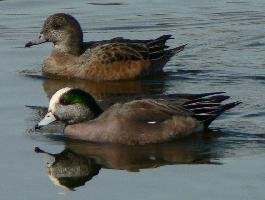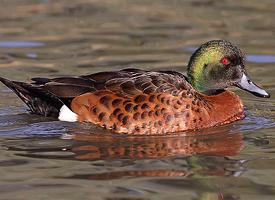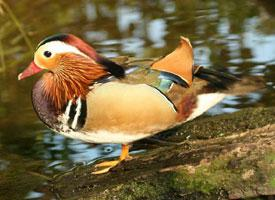
Popis zvířete
The American Wigeon (Mareca americana), also known as the Baldpate due to the white stripe on the male's head that resembles a bald man's head, is a medium-sized bird that graces the waters of North America. This species is a member of the Anatidae family, which includes ducks, geese, and swans. The American Wigeon is particularly noted for its distinctive physical features, behaviors, and migration patterns, making it a subject of interest for birdwatchers and wildlife enthusiasts.Physical Description:
The American Wigeon is a striking bird, especially the male, with its bold and contrasting plumage. Adult males display a unique white crown and forehead, earning them the nickname "Baldpate." Their eyes are highlighted by a black patch, and they have a broad green stripe extending from the eye to the back of the head. The body is characterized by a pinkish-brown chest, gray flanks, and a black rear end. The bill is bluish-gray with a black tip, and the wings have a distinctive white patch visible during flight.
Female American Wigeons are more subdued in coloration, with mottled brown bodies that provide excellent camouflage among marsh vegetation. They have a smudgy gray-brown head with a darker crown and eye stripe. Both sexes have a white belly and undertail coverts, but the female's plumage is designed more for concealment than display.
Juveniles resemble females but are generally duller, with less distinct markings. One of the most distinguishing features of all American Wigeons, regardless of sex or age, is their unique, high-pitched whistling call, which is often heard before the birds are seen.
Behavior and Diet:
American Wigeons are dabbling ducks, feeding at the surface of the water rather than diving. They are known for their opportunistic feeding habits, often stealing food from other ducks. Their diet is varied and includes aquatic plants, grasses, and occasionally insects and other small aquatic creatures. This adaptability in diet allows them to thrive in a variety of habitats.
Habitat and Distribution:
The American Wigeon breeds in the northern regions of North America, from Alaska and the Canadian Arctic southward into the northern United States. They prefer shallow freshwater ponds, lakes, and marshes with abundant vegetation for breeding and feeding. In the winter, they migrate to the southern United States, the Pacific and Atlantic coasts of North America, and down into Central America. During migration, they can often be found in estuaries, agricultural fields, and coastal bays.
Reproduction:
Breeding typically begins in late April to early June, depending on the latitude. The nest is a shallow depression on the ground, lined with plant material and down feathers, concealed in dense vegetation near water. The female lays 6 to 12 creamy white eggs, which she incubates alone for about 25 days. The male may remain nearby but does not participate in nesting or care of the young. Once hatched, the ducklings are precocial and able to leave the nest within a day, guided by the female to water where they begin feeding on insects and plants.
Conservation Status:
The American Wigeon is currently classified as Least Concern by the International Union for Conservation of Nature (IUCN), thanks to its wide range and large population. However, like many waterfowl species, they face threats from habitat loss and degradation, particularly in their breeding areas. Conservation efforts focus on preserving wetland habitats and managing waterfowl populations to ensure the long-term survival of this and other species.
In summary, the American Wigeon is a fascinating and adaptable bird, notable for its striking appearance, intriguing behaviors, and extensive migratory patterns. Its presence enhances the biodiversity of wetland ecosystems across North America, making it a cherished species among birdwatchers and conservationists alike.
Podobná zvířata
Nové fotografie zvířat
Top 10 zvířat
- Chinese water dragon (Physignathus cocincinus)
- Dolphin gull (Leucophaeus scoresbii)
- Japanese macaque (Macaca fuscata)
- Galápagos tortoise (Geochelone nigra complex)
- Colombian red howler (Alouatta seniculus)
- Sea urchins (Echinoidea)
- Barbary macaque (Macaca sylvanus)
- Moustached guenon (Cercopithecus cephus)
- Diana monkey (Cercopithecus diana)
- Angolan talapoin (Miopithecus talapoin)


